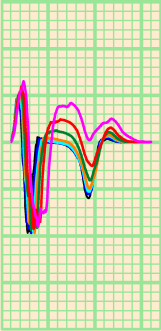Heart Rhythm 7:238-248, February 2010

links
Article doi:10.1016/j.hrthm.2009.10.007
Free full text as Featured Article
Editorial Comment doi:10.1016/j.hrthm.2009.10.032
abstract
Background: The Brugada sign has been associated with mutations in SCN5A and with right ventricular structural abnormalities. Their respective role in the Brugada sign and in the associated ventricular arrhythmias is unknown.
Objective: This study's aim was to delineate the role of structural abnormalities and sodium channel dysfunction in the Brugada sign.
Methods: We determined the activation and repolarization characteristics of the explanted heart of a patient with a loss-of-function mutation in SCN5A (G752R) and dilated cardiomyopathy after induction of right-sided ST-segment elevation by ajmaline. Additionally, we simulated right ventricular structural discontinuities and sodium channel dysfunction in a computer model encompassing the heart and thorax.
Results: In the explanted heart, disappearance of local activation in unipolar electrograms at the basal right ventricular epicardium was followed by monophasic ST-segment elevation. The local origin of this phenomenon was confirmed by coaxial electrograms. Neither early repolarization nor late activation correlated with the ST-segment elevation. At sites of local ST-segment elevation, the subepicardium was interspersed with adipose tissue and contained more fibrous tissue than either the left ventricle or control hearts. In computer simulations entailing right ventricular structural discontinuities, reduction of sodium channel conductance or size of the gaps between introduced barriers resulted in subepicardial excitation failure or delayed activation by current-to-load mismatch and in the Brugada sign on the ECG.
Conclusions: Right ventricular excitation failure and activation delay by current-to-load mismatch in the subepicardium can cause the Brugada sign. Therefore, current-to-load mismatch may underlie the ventricular arrhythmias in patients with the Brugada sign.
lay abstract
The Brugada syndrome is a combination of changes in the electrocardiogram (ECG) that is associated with a high risk of sudden cardiac death. In contrast to many other cardiac diseases, Brugada syndrome is not associated with high age or an unhealthy style of living. It occurs in apparently healthy subjects, and it is especially prevalent in males of 20 to 40 years of age.
A syndrome is not the same as a disease. It is merely a set of symptoms (such as ECG changes) that are often seen together. The Brugada syndrome is defined as a combination of an elevated "ST segment" and negative "T wave" in the ECG, in the absence of structural heart disease or myocardial ischemia. Whether one or more particular diseases underly the syndrome is not yet known. In 30% of cases, genetic mutations have been found whose effects can help to induce the syndrome. Other studies, however, found structural heart disease in 100% of the investigated patients. According to the definition, then, these patients did not have Brugada syndrome. This contradiction occurs because the structural damage is so subtle that it is not detected during clinical investigations, but only on autopsy.
The role of structural damage in Brugada syndrome was not clear. In this study, we investigated what role it can play in combination with other factors. Using a combination of experimental and computer model studies, we found that structural damage is necessary to produce the observed ECG changes. This explains why the syndrome rarely occurs in subjects younger than 20 years: structural damage needs time to develop, and depends on many genetic and environmental factors.
funding
This work was supported by The Netherlands Heart Foundation (2005T024 [Dr Bezzina], 2003T302 [Dr. Wilde], 2005B092 [Dr. de Bakker, Dr. Linnenbank], 2008B062 [Dr. Coronel]); the Interuniversity Cardiology Institute of the Netherlands, the Royal Netherlands Academy of Arts and Sciences (Dr. Tan), the Netherlands Organisation for Scientific Research (ZonMW-VICI 918.86.616 [Dr. Tan]), and the Research Center of Montréal Sacré-Coeur hospital (Dr. Potse). Computational resources for this work were provided by the Réseau québécois de calcul de haute performance (RQCHP).

